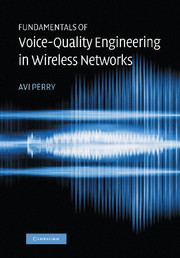Book contents
- Frontmatter
- Contents
- Preface
- List of abbreviations
- Introduction
- Part I Voice-quality foundations
- Part II Applications
- 3 Electrical echo and echo cancelation
- 4 Acoustic echo and its control
- 5 Noisy ambience, mobility, and noise reduction
- 6 Speech-level control
- Part III Wireless architectures
- Part IV A network operator's guide for selecting, appraising, and testing a VQS
- Part V Managing the network
- Part VI Afterthoughts and some fresh ideas
- Part VII Recordings
- Glossary of common voice-quality systems terminology
- Brief summary of echo cancelation and VQS major standards
- Brief summary of key voice-quality assessment standards
- Bibliography
- Index
5 - Noisy ambience, mobility, and noise reduction
Published online by Cambridge University Press: 24 May 2010
- Frontmatter
- Contents
- Preface
- List of abbreviations
- Introduction
- Part I Voice-quality foundations
- Part II Applications
- 3 Electrical echo and echo cancelation
- 4 Acoustic echo and its control
- 5 Noisy ambience, mobility, and noise reduction
- 6 Speech-level control
- Part III Wireless architectures
- Part IV A network operator's guide for selecting, appraising, and testing a VQS
- Part V Managing the network
- Part VI Afterthoughts and some fresh ideas
- Part VII Recordings
- Glossary of common voice-quality systems terminology
- Brief summary of echo cancelation and VQS major standards
- Brief summary of key voice-quality assessment standards
- Bibliography
- Index
Summary
Chapter 5 is devoted to the subject of noise reduction. Noise reduction is the most complicated feature among the voice-quality-assurance class of applications. It also requires a higher-level understanding of mathematics. This discussion, however, substitutes numerous mathematical expressions for intuition, ordinary analogies, and logical reasoning, supplemented by graphical and audio illustrations.
The analysis gets underway with the definition of noise, a definition consistent with the principles and characterization employed by a typical noise-reduction algorithm. It then introduces and explains the mathematical concept of time and frequency domains and the transformation process between the two. Once the reader is armed with the understanding of time- and frequency-domain representations, the analysis proceeds to a discussion of the noise-estimation process. The presentation then moves ahead to examine the suppression algorithm, which employs the noise-estimation results in its frequency-band attenuation procedures. The next segment contains a presentation covering the final algorithmic steps, which involve scaling and inverse transformation from frequency to time domains.
The next section in Chapter 5 reflects on key potential side effects associated with noise-reduction algorithms including treatment of non-voice signals. It points to key trade-offs and adverse-feature interactions that may occur in various GSM and CDMA networks – a subject that is covered much more thoroughly in Part V – Managing the network. The final section offers an examination of the network topology and placement of the noise-reduction application within it.
Noise in wireless networks
Background acoustic noise is a major voice-quality irritant that is, unfortunately, abundant in wireless communications.
- Type
- Chapter
- Information
- Fundamentals of Voice-Quality Engineering in Wireless Networks , pp. 112 - 132Publisher: Cambridge University PressPrint publication year: 2006



